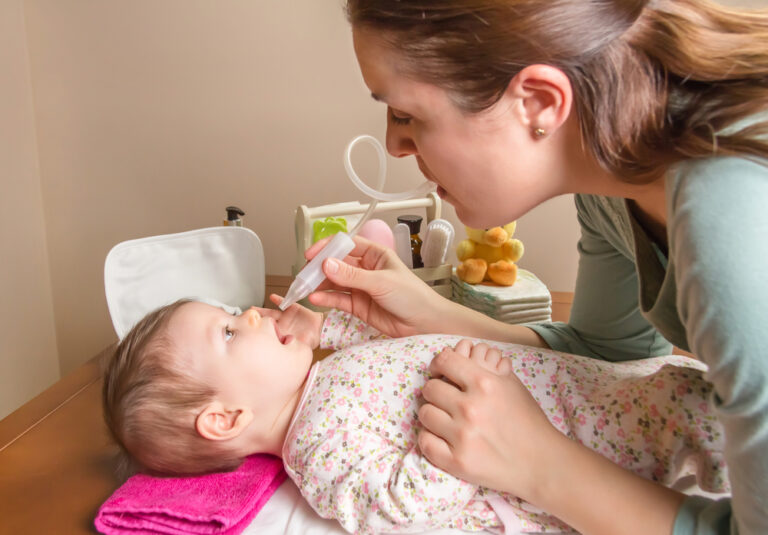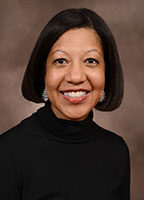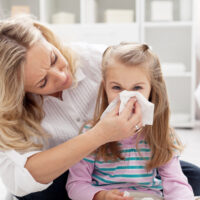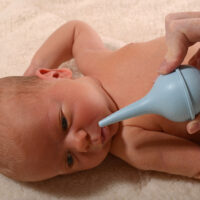Stuffy and runny noses are inevitable in infants and children. Because babies cannot blow their own noses, keeping their nasal passages clear is important for easier breathing, especially at night and during feedings. Below, we’ll discuss how to remove mucous from a baby’s nose with a bulb syringe or nasal aspirator. We’ll also discuss some tips on how to manage nasal congestion, and remove baby boogers easily.
How to Get Boogers Out with a Nasal Aspirator
A nasal aspirator is any device that creates suction in order to remove mucous from your baby’s nose. The most well-known type is the bulb syringe, however, several others have also been developed. Nasal aspirators like the Fridababy NoseFrida Nasal Aspirator use a tube with a filter to collect mucous as the parent aspirates from the other end. The BabySmile’s Nasal Aspirator S-503 uses a tube attached to a machine to create suction. You can find out more about our recommendations for the best nasal aspirator here.
Step 1: Deciding Which Tools You Need
If your baby has runny, wet boogers, you should only use a bulb syringe or nasal aspirator. The mucus can be easily removed with either device. Avoid using tools like a Q-tip, rolled up toilet paper, tweezers, or other objects in your baby’s nose; if he or she moves the wrong way, you may cause trauma to the inside of the nose and bleeding. With toilet paper, there’s also a risk of a piece breaking off and obstructing their nasal passages.
If your baby has dried, hardened boogers, it’s best to soften them first. This will prevent them from scraping the inside of your baby’s nose, and make them easier to remove. The salt and water of nasal saline drops softens hard, dried mucous (source). In most cases, about 3-4 drops in each nostril are sufficient to break up boogers. When using an aspirator, your infant should lie flat on his or her back during the nasal cleaning. Allowing your baby to lie calmly for a few minutes before this procedure can be helpful.
If you don’t have saline drops at home, the mist of a humidifier or steam from a shower can work well. This moisture will humidify the air as well as the inside of your baby’s nose. Alternatively, you can make your own saline drops by combining one cup of warm water to 1/4 teaspoon of salt. You’ll want to make a fresh saline solution each time that you use it.
Step 2: Getting Your Baby to Stay Still
I personally have always dreaded cleaning my baby’s nose because it has been difficult to get them to lie still. Babies are too young to understand that you are trying to help, and having a bulb syringe or aspirator in their nose probably feels weird.
The easiest way to get your baby to stay still is to have someone help you. If your baby is young enough, swaddling them may make the job easier. If swaddling isn’t an option, try lying your baby on a flat surface such as a changing table. The person assisting you should first stand at the head of the table. While holding the infant’s head in place with their forearms, your assistant’s hands are free to hold down the baby’s arms while you aspirate the nose.
Step 3: Removing the Boogers
The method of cleaning your baby’s nose depends on which device you are using. Always refer to the manufacturer’s instructions on how to safely use their product. Below, we’ll describe the basic steps.
How to Use a Bulb Syringe
To use a bulb syringe, start by squeezing the round end to push the air out. Then, while continuing to squeeze, put the tip gently in your baby’s nose, then release the bulb slowly to suction the mucous. Squeeze the bulb again into a tissue to expel the mucous. Repeat these steps until your baby can breathe comfortably again (source).
How to Use a Nasal Aspirator
If you have a manual nasal aspirator similar to the NoseFrida mentioned above, you’ll first need to assemble the product. Usually, there is a filter, a mouthpiece for you, and a tube that goes into your baby’s nose. Once it is assembled, you’ll position the tube into your baby’s nose, and suck in air using the mouthpiece. The filter prevents the mucous from going into your mouth.
An electrical nasal aspirator works similarly. After assembling the machine, position the nasal tube into your little one’s nose. Then, turn on the machine, and gently move it around to apsirate all of the mucous.
Step 4: Clean Up
Each time you use your nasal aspirator or bulb syringe, it should be cleaned thoroughly. In addition to collecting viruses or bacteria, any moisture left in the aspirator can cause mildew or mold accumulation. Exposing your baby to any of these substances can prolong their illness, so you’ll want to clean the device thoroughly after each use.
First, to clean a bulb syringe, place it in a small container of hot, soapy water. Squeeze the air out of the bulb, then release it to draw the soapy water inside. Shake the bulb around, then squeeze to release the dirty water. Do this several times until the bulb is clean. Second, fill another container with plain water for rinsing. You’ll want squeeze and release the bulb several times, shaking it around as you do so, in order to remove all of the soap.
If you have another type of nasal aspirator, you’ll need to disassemble it and clean all of the components. This includes flushing out the suction tubes. You’ll also need to change the filter as recommended by the manufacturer (instructions for cleaning the nasal aspirator should be included with the packaging).
More Tips for Cleaning Your Baby’s Nose
Some other things you can do to help get boogers out of your baby’s nose:
- Use breastmilk. Breastmilk is considered a miracle liquid for many reasons, not just to nourish your baby. Although further research is necessary, there is promising evidence that breast milk may be helpful when applied topically (source). Just add a few drops into your baby’s nose to loosen the mucus. Breastmilk also has antibacterial properties that may help when your little one is fighting a bacterial infection. Before using breastmilk as a non-traditional treatment, however, you should have a discussion with your pediatrician.
- Run a humidifier (especially at night). Cool mist humidifiers are useful for loosening mucus in your baby’s nose, throat, and lungs. However, you will want to test the amount of moisture in the air during use. Humidity levels above 60% are quite high, and can damage the woodwork in your house. Be sure to clean your humidifier regularly to prevent the growth of mold or bacteria (source).
- Use Boogie Wipes for dry boogers. Boogie Wipes are saturated with saline solution, so they break up boogers easily. They’re especially useful for dry, harder-to-remove ones.
- Get your baby to sneeze. Sneezing is the only way for infants to rid their noses of anything that clogs it. You can encourage a sneeze by tickling the tip of their nose with a tissue.
FAQs about Cleaning Baby Noses
Is it safe to use essential oils to clean my baby’s nose?
Unless your physician recommends it, you should not use essential oils to clean your baby’s nose. A popular home remedy involves using eucalyptus oil in your baby’s nose. While this may break up mucus, the most common kind of eucalyptus oil sold is actually neurotoxic to children under two. In addition, peppermint oil can cause seizures in infants (source). Allergists also discourage the use of room diffusers with essential oils due to the risk of causing asthma symptoms (source).
Can I use a syringe full of water to rinse my baby’s nose?
There is a viral video that shows a woman squirting water up her baby’s nose to get it clean. While the baby in the video is smiling, most baby’s are not going to be happy if you try this. A full syringe of water is dangerous to your baby’s nose. Not only is it unpleasant, but it is likely that your baby will inhale and aspirate it. This can lead to pneumonia if it goes into your child’s lungs. Only a few drops of saline solution should be used to clean your baby’s nose (source).
What causes stuffy and runny noses in babies?
Babies develop stuffy or runny noses for a number of reasons. They have smaller nasal passages than adults, so it’s very easy for them to get clogged. Infants who “spit up” frequently after feedings may develop nasal congestion from refluxed milk (source). Infections, poor air quality, and even dry air can also cause nasal congestion (source). Dry air is a common problem during cold weather months when windows are closed and the heat is on.
Final Word
Hopefully, this article is helpful for parents wondering how to successfully clean a baby’s nose. These tips should keep your little one’s nasal passages clear, whether you are using a bulb syringe or another type of nasal aspirator. Humidifying the air in your home and checking air the quality can help your baby to breathe easier, especially if he or she frequently suffers from runny or stuffy noses.



